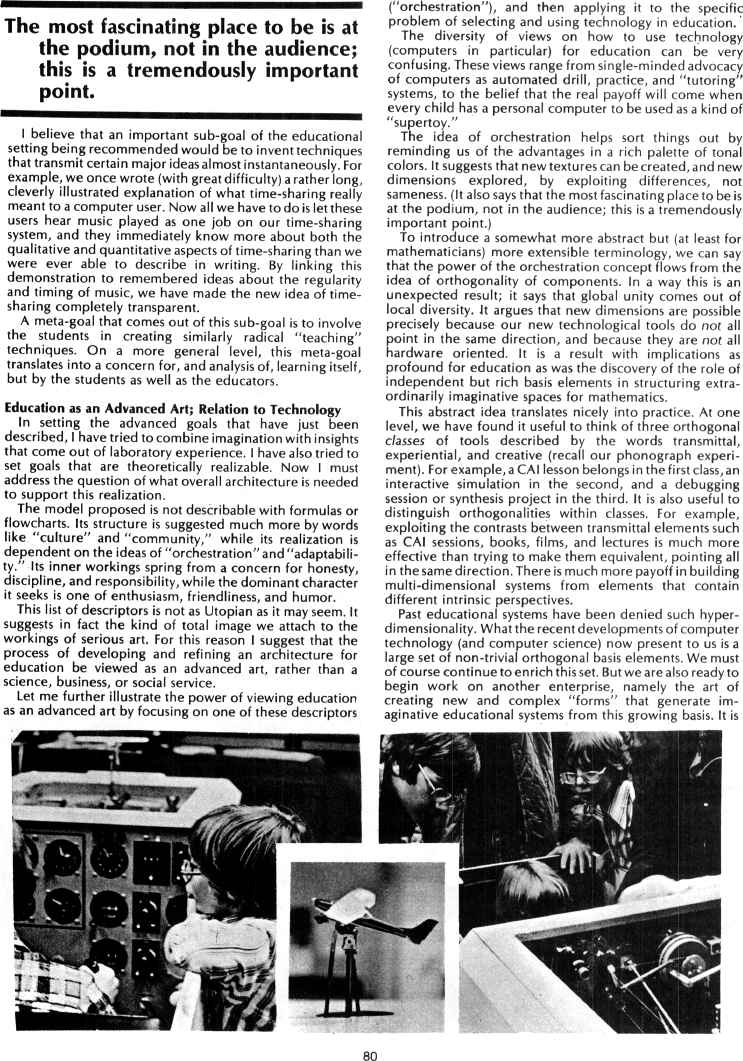The Best of Creative Computing Volume 2 (published 1977)
The Art Of Education: Blueprint For A Renaissance

The most fascinating place to be is at the podium, not in the audience; this is
a tremendously important point.
****
I believe that an important sub-goal of educational setting being recommended
would be to invent techniques that transmit certain major ideas almost
instantaneously. For example, we once wrote (with great difficulty) a rather
long, cleverly illustrated explanation of what time-sharing really meant to a
computer user. Now all we have to do is let these users hear music played as one
job on our time-sharing system, and they immediately know more about both the
qualitative and quantitative aspects of time-sharing than we were ever able to
describe in writing. By linking this demonstration to remembered ideas about the
regularity and timing of music, we have made the new idea of time sharing
completely transparent.
A meta-goal that comes out of this sub-goal is to involve the students in
creating similarly radical "teaching" techniques. On a more general level, this
meta-goal translates into a concern for, and analysis of, learning itself, but
by the students as well as educators.
****
Education as an Advanced Art; Relation to Technology
In setting the advanced goals that have just been described, I have tried to
combine imagination with insights that come out of laboratory experience. I have
also tried to set goals that are theoretically realizable. Now I must address
the question of what overall architecture is needed to support this realization.
The model proposed is not describable with formulas or flowcharts. Its Structure
is suggested much more by words like "culture" and "community," while its
realization is dependent on the ideas of "orchestration" and "adaptability." Its
inner workings spring from a concern for honesty, discipline, and
responsibility, while the dominant character it seeks is one of enthusiasm,
friendliness, and humor.
This list of descriptors is not as Utopian as it may seem. It suggests in fact
the kind of total image we attach to the workings of serious art. For this
reason I suggest that the process of developing and refining an architecture for
education be viewed as an advanced art, rather than a science, business, or
social service.
Let me further illustrate the power of viewing education as an advanced art by
focusing on one of these descriptors ("orchestration"), and then applying it to
the specific problem of selecting and using technology in education.
The diversity of views on how to use technology (computers in particular) for
education can be very confusing. These views range from single-minded advocacy
of computers as automated drill, practice, and "tutoring" systems, to the belief
that the real payoff will come when every child has a personal computer to be
used as a kind of "supertoy."
The idea of orchestration helps sort things out by reminding us of the
advantages in a rich palette of tonal colors. lt suggests that new textures can
be created, and new dimensions explored, by exploiting differences, not
sameness. (It also says that the most fascinating place to be is at the podium,
not in the audience; this is a tremendously important point.)
To introduce a somewhat more abstract but (at least for mathematicians) more
extensible terminology, we can say that the power of the orchestration concept
flows from the idea of orthogonality of components. ln a way this is an
unexpected result; it says that global unity comes out of local diversity. It
argues that new dimensions are possible precisely because our new technological
tools do not all point in the same direction, and because they are not all
hardware oriented. It is a result with implications as profound for education as
was the discovery of the role of independent but rich basis elements in
structuring extraordinarily imaginative spaces for mathematics.
This abstract idea translates nicely into practice, At one level, we have found
it useful to think of three orthogonal classes of tools described by the words
transmittal, experiential, and creative (recall our phonograph experiment). For
example, a CAI lesson belongs in the first class,an interactive simulation in
the second, and a debugging session or synthesis project in the third. It is
also useful to distinguish orthogonalities within classes. For example,
exploiting the contrasts between transmittal elements such as CAI sessions,
books, films, and lectures is much more effective than trying to make them
equivalent, pointing all in the same direction. There is much more payoff in
building multi-dimensional systems from elements that contain different
intrinsic perspectives.
Past educational systems have been denied such hyperdimensionality. What the
recent developments of computer technology (and computer science) now present to
us is a large set of non-trivial orthogonal basis elements. We must of course
continue to enrich this set. But we are also ready to begin work on another
enterprise, namely the art of creating new and complex "forms" that generate
imaginative educational systems from this growing basis. It is
****
[Image]
[Image]
[Image]


